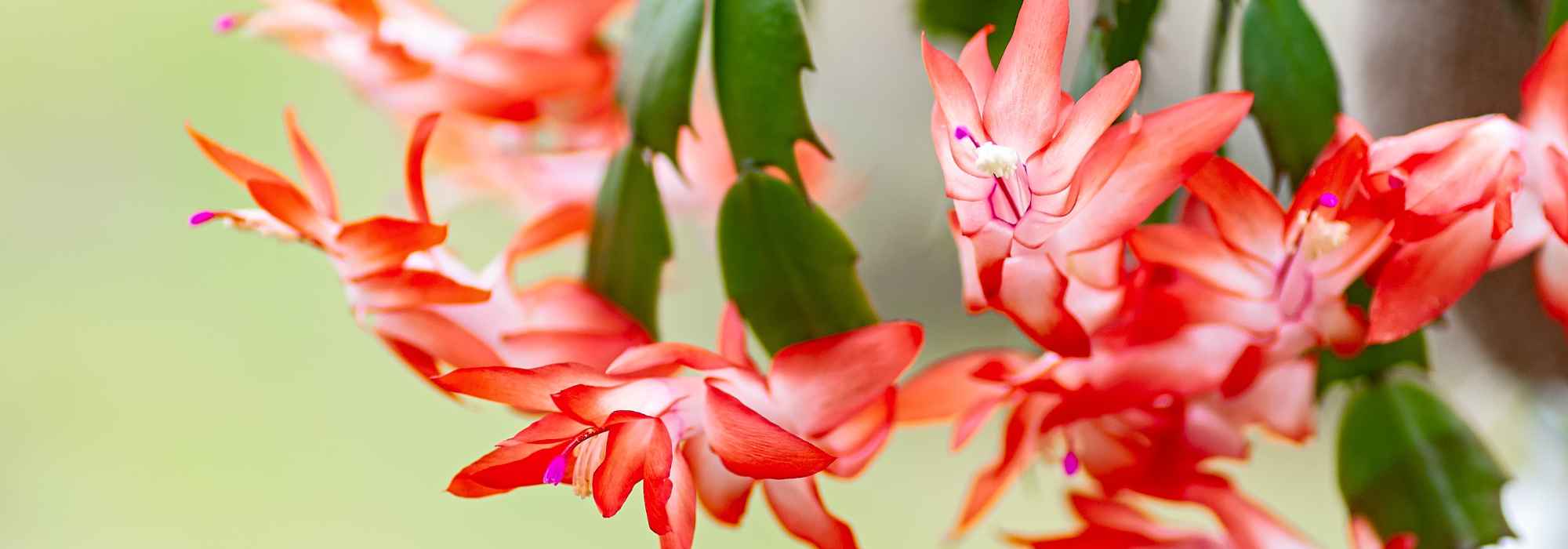
Christmas cactus, Schlumbergera : growing and care for a stunning winter flowering
Contents
The Christmas cactus in a nutshell
- This is a thornless cactus, prized for its vibrant winter flowering between November and January.
- In terms of care, the Christmas cactus thrives in bright light without direct sunlight, a well-draining soil, and moderate watering.
- Propagation by cuttings of the Christmas cactus is easy to achieve, and repotting every two or three years is sufficient to support its growth.
- The Christmas cactus can be moved outdoors in summer, provided it is brought back inside before the first chills.
- Graphic and luminous, it fits into all interior styles and adds dynamism to winter decor.
The word from our expert
A must-have indoor plant in winter, the Schlumbergera, better known as the Christmas Cactus, captivates with its colourful winter flowering, as well as its graphic and trailing foliage. Among the most common varieties, Schlumbergera truncata stands out for its early flowering, often as early as November, earning it the nickname “Thanksgiving Cactus.”
The Christmas Cactus is grown exclusively indoors in our latitudes, where it finds stable and bright conditions. It thrives in bright but filtered light, away from direct sunlight, and at temperatures between 18 and 25°C. In autumn, a slight reduction in light and temperature encourages the appearance of flower buds. Caring for the Christmas Cactus involves a few simple steps: moderate watering, well-draining soil, and avoiding cold drafts are enough to ensure regular flowering. For the substrate, a light mix of compost, perlite, or coarse sand helps prevent excess water, which this plant cannot tolerate.
During the summer months, it is possible to move the plant outdoors to a shaded and sheltered spot, allowing it to benefit from fresh air and boosting its vitality. But beware—if you’re wondering whether you can grow the Christmas Cactus outdoors or indoors, the answer is clear: it enjoys the outdoors only in summer and must be brought back inside as soon as nighttime temperatures approach 10°C.
Propagating the Christmas Cactus, on the other hand, is within everyone’s reach. A simple, well-chosen segment can produce a robust and floriferous new plant. Let yourself be charmed by this easy-to-care-for and endearing indoor plant, and discover our varieties of Christmas Cactus!
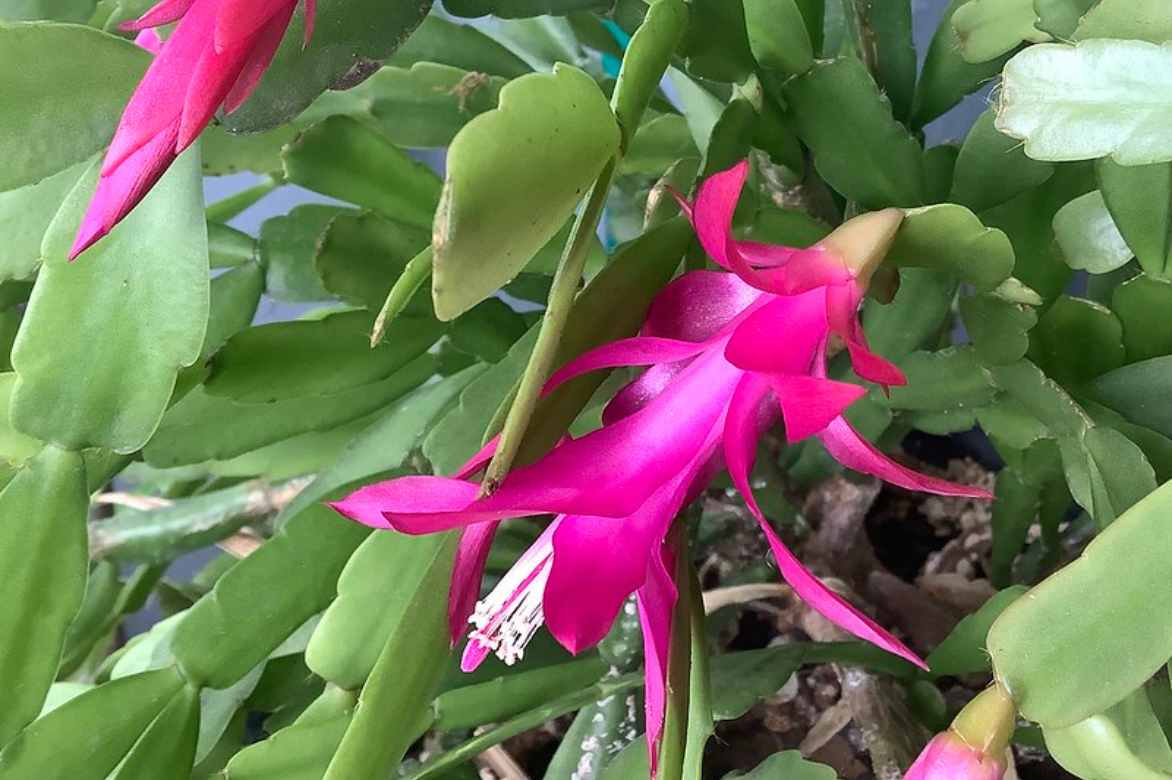
Schlumbergera buckeyi (©El Cajon Yatch Club)
Botany and description
Botanical data
- Latin name Schlumbergera sp.
- Family Cactaceae
- Common name Christmas cactus, Thanksgiving cactus
- Flowering November to January
- Height 20 to 40 cm
- Exposure bright light without direct sunlight
- Soil type light, well-draining, humus-bearing (compost + perlite or coarse sand)
- Hardiness Frost-sensitive
The Schlumbergera belongs to the botanical family Cactaceae, in other words, it is a cactus, even if it doesn’t always have the classic appearance with its thorns and desert-like forms. The genus name pays homage to Frédéric Schlumberger, a 19th-century French collector specialising in cacti, whose work helped popularise this plant in Europe.
It is commonly known as the “Christmas cactus” or “Thanksgiving cactus”. These vernacular names directly refer to their natural flowering period, which spans from late autumn to early winter, depending on the species and hybrids. For example, Schlumbergera truncata, with its early flowering, is often associated with Thanksgiving (late November), while Schlumbergera x buckleyi, which flowers later, is known to bloom around Christmas.
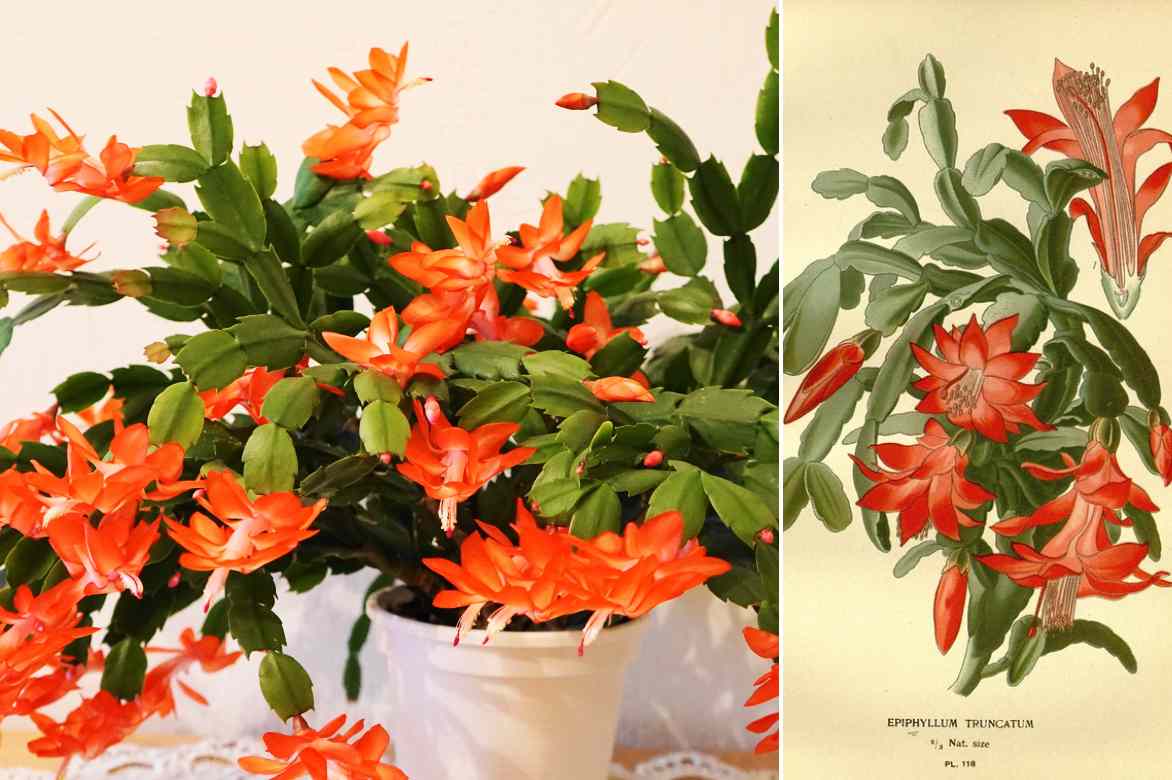
Schlumbergera tructatum, on the right, botanical plate circa 1906
In their natural habitat, Schlumbergera are native to the humid tropical forests of southeastern Brazil, primarily in the states of Rio de Janeiro, São Paulo, and Minas Gerais. They grow as epiphytes or lithophytes, attached to tree branches or rocky walls, in shady, cool, and humid environments, at altitudes ranging between 700 and 1700 metres. Unlike desert cacti, they are adapted to conditions of high atmospheric humidity, with substrates rich in organic matter, well-draining, but never completely dry.
They are mostly grown indoors in temperate regions due to their very low hardiness. These tropical plants cannot tolerate low temperatures: they begin to suffer below 10 °C, and frost is quickly fatal to them. Therefore, they cannot be left outdoors year-round, except in subtropical or very mild coastal areas. However, they can be placed outside temporarily during the summer, sheltered from direct sunlight and harsh weather, before being brought back indoors in autumn to avoid any exposure to cold.
Among the most commonly cultivated species, Schlumbergera truncata and Schlumbergera x buckleyi dominate the horticultural market. The former, easily recognisable by its toothed segments and upright flowering, is often marketed as the “Thanksgiving cactus”, while the latter, with its more rounded segments and pendulous flowers, is associated with the traditional “Christmas cactus”.
The Schlumbergera has a trailing or semi-trailing habit, particularly noticeable in mature specimens, with a flexible and jointed silhouette that clearly distinguishes it from other cacti. Its root system is relatively underdeveloped, shallow, and fasciculate, adapted to an epiphytic or lithophytic life; it primarily ensures anchorage and rapid absorption of ambient moisture and nutrients available in organic debris. The plant typically reaches between 20 and 40 cm in height under cultivation conditions, but its spread can be much larger due to the gradual elongation of its segmented stems.
The stems are composed of flattened cladodes, called segments, which perform photosynthetic functions. These segments, often mistaken for leaves, lack a true lamina; they usually measure between 3 and 6 cm in length and 2 to 4 cm in width, with toothed or crenate margins depending on the species. Their texture is fleshy, glossy, and bright to dark green in colour, sometimes tinged with red when exposed to intense light or stress. Each joint features a tiny areole (a vestige of its cactus origins and typical of cacti), which may occasionally bear a few very fine bristles.

The foliage consists of cladodes in Christmas cacti
Flowering occurs at the tips of the terminal segments. The flowers are zygomorphic, tubular, with tepals arranged in several overlapping rows, usually curved backward. They can reach 6 to 8 cm in length and come in a wide range of colours depending on the cultivar: white, pink, red, orange, yellow, or purple. Indoors, the Schlumbergera flowers quite easily, especially if a rest period in autumn is observed, marked by a gradual drop in temperatures and reduced light. The flowering lasts several days, and under good conditions, the plant can produce several successive waves of flowers. Fruiting is rare in ornamental cultivation, but when it occurs, it yields a small, fleshy, ovoid fruit, red or pink in colour, containing numerous tiny seeds.
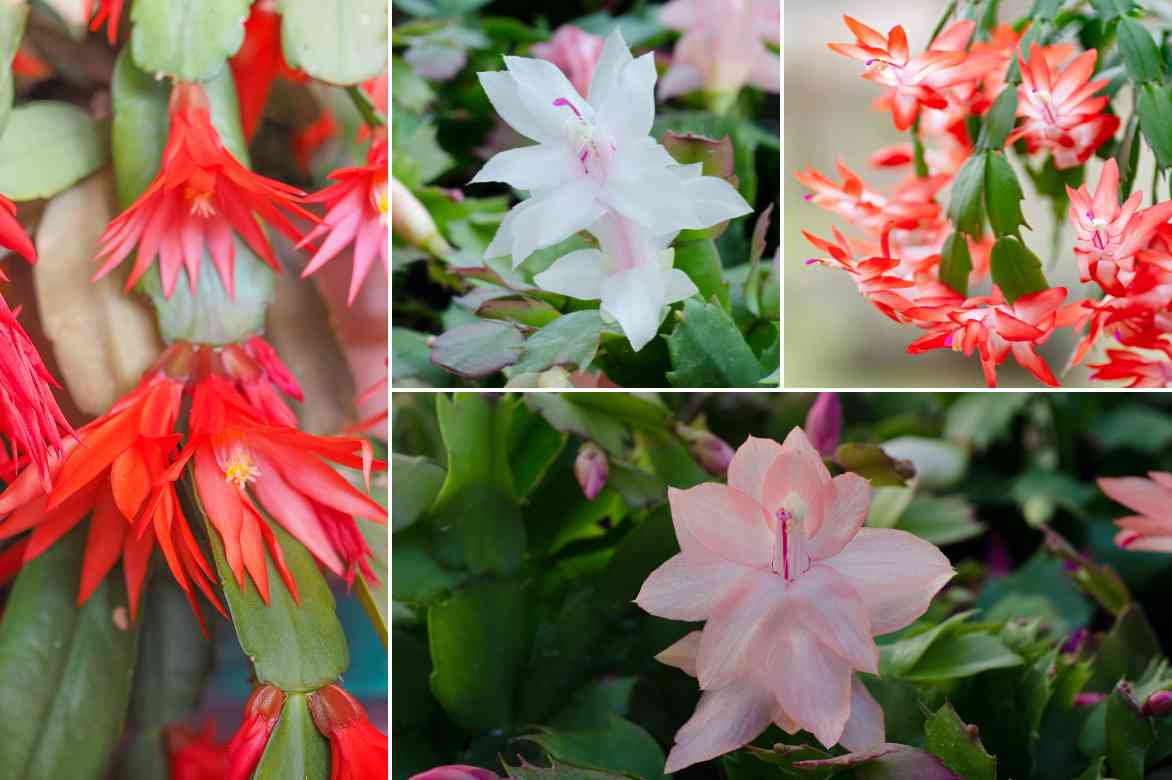
Depending on the cultivar, Schlumbergera produce flowers ranging from white to vermilion red
Main species and varieties of Christmas cacti
Growing Schlumbergera Indoors
Where to Place a Christmas Cactus in the House?
The Schlumbergera thrives indoors, provided it is given an environment close to its natural habitat. It enjoys bright, indirect light and tolerates gentle sunlight, especially in the morning or late afternoon. An ideal spot is near an east or north-east-facing window, where the light is abundant but not excessive. It can also be placed in a south or west-facing location if protected by a sheer curtain to filter direct sunlight. Avoid overly dark spots, as they can hinder its growth and flowering, as well as direct heat sources like radiators.
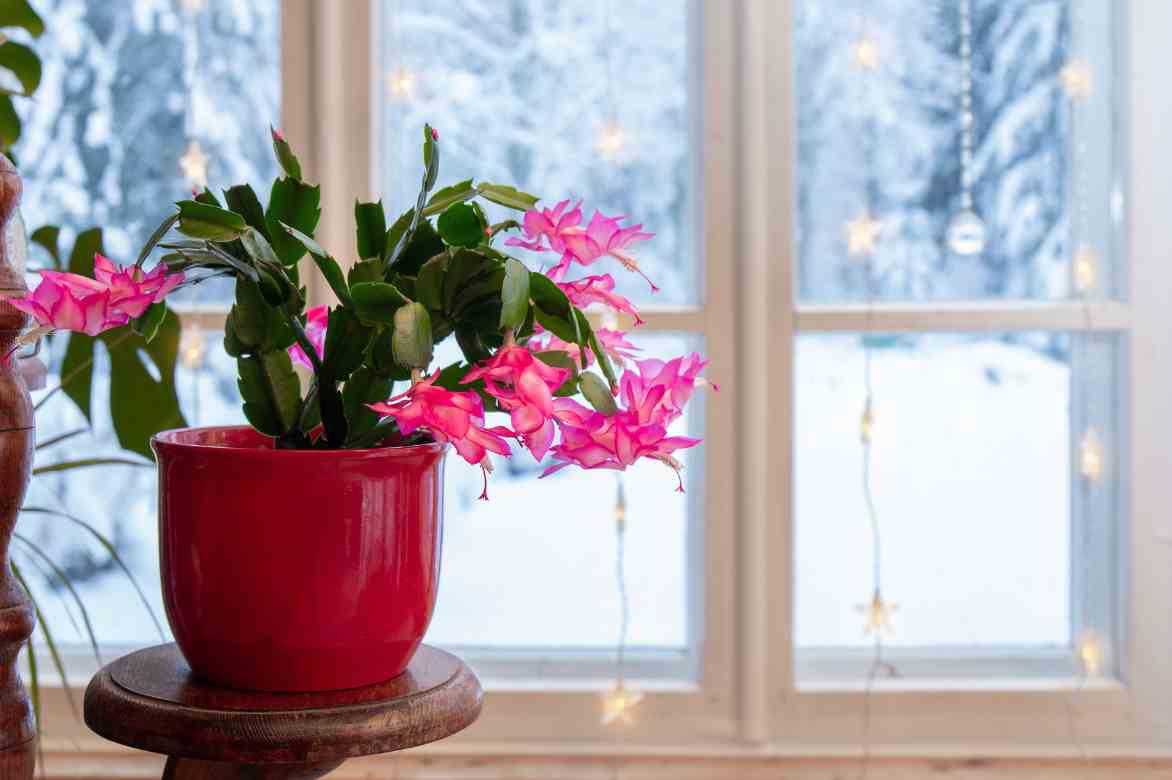
Choose a bright location, but without direct sunlight
It tolerates typical indoor temperatures well, between 18 and 25 °C during active growth. It is important to protect it from cold: below 10 °C, it becomes stressed, which can slow its development or cause segments to drop.
In regions with a mild climate, particularly along the Mediterranean coast or in certain areas of western France, it can be moved outdoors during the warmer months, from late spring to early autumn. It will appreciate a bright spot, but without direct sunlight, such as partial shade under a tree or on a sheltered terrace. However, as nighttime temperatures begin to drop in autumn, it must be brought back indoors to protect it from the cold.
Unlike other tropical plants, it does not require misting: moderately dry air will not harm it as long as watering is adjusted. In autumn, a gradual drop in temperature and reduced light encourage flower induction, and this period of relative rest is essential for abundant winter flowering.
When to Plant the Schlumbergera in a Pot?
The Schlumbergera can be potted year-round, as long as it is grown indoors where conditions are stable and controlled. However, the ideal time for potting is after flowering, usually between late winter and early spring. This allows the plant to adapt to its new substrate and root actively during its growth phase. Avoid potting during or just before flowering, as this can disrupt flower initiation and cause buds to drop.
How to Plant the Christmas Cactus in a Pot?
Substrate
The Schlumbergera requires a slightly acidic to neutral pH substrate (between 5.5 and 6.5), very well-draining, airy, and light, mimicking the conditions of its natural tropical habitat. Here is the recommended composition:
- Indoor plant compost or cactus compost as the main base
- Approximately 30% perlite, coarse sand, or fine pumice to ensure good drainage
- Optional: a small amount of coconut coir or composted bark to improve aeration and slight moisture retention.
This mixture helps prevent root suffocation and rot while retaining just enough moisture between waterings.
Planting
- Choose a pot with drainage holes, slightly larger than the root ball. The Schlumbergera prefers being slightly snug.
- Place a drainage layer at the bottom of the pot: clay pebbles, gravel, or pottery shards.
- Prepare the light, well-draining mixture.
- Place the root ball in the pot, positioning the collar just above the substrate level.
- Fill in the gaps, lightly tamping the compost without compressing it too much.
- Water moderately immediately after planting, then let the substrate dry on the surface before watering again.
- Place the plant in a bright spot, away from intense direct sunlight, and avoid excess moisture in the weeks following planting.
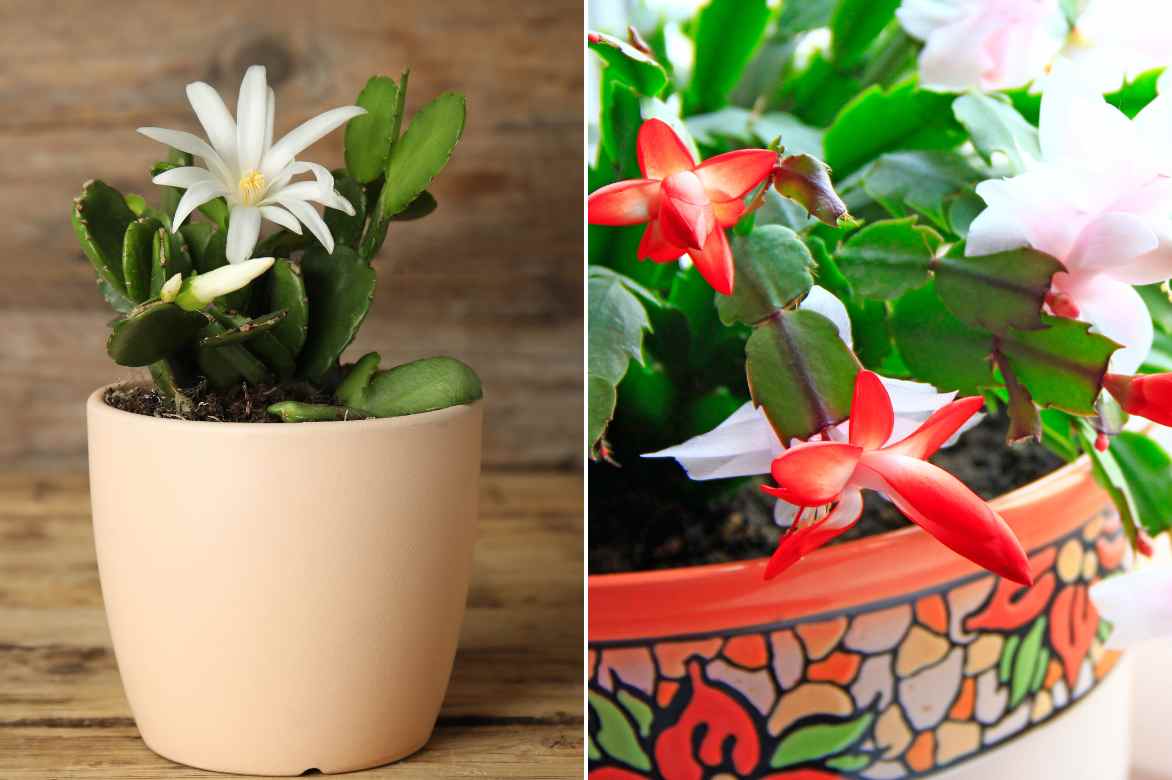
A small-sized pot suits the Christmas cactus well
Christmas Cactus Care
Growing a Christmas Cactus indoors is relatively straightforward, provided you follow a few basic principles suited to its tropical epiphytic nature. Here are the key care tips to keep it healthy and encourage its annual flowering.
Watering
Watering should be regular but moderate. The Schlumbergera dislikes excess water: it is sensitive to stagnant moisture, which can cause root rot.
- During the growth period (spring to autumn), water when the substrate has dried on the surface, typically every 7 to 10 days.
- During the flowering period (winter), maintain slight moisture without waterlogging, spacing out watering slightly.
- Outside these periods, particularly in autumn during flower initiation, reduce watering to encourage bud formation.
- Always use water at room temperature, preferably non-calcareous.
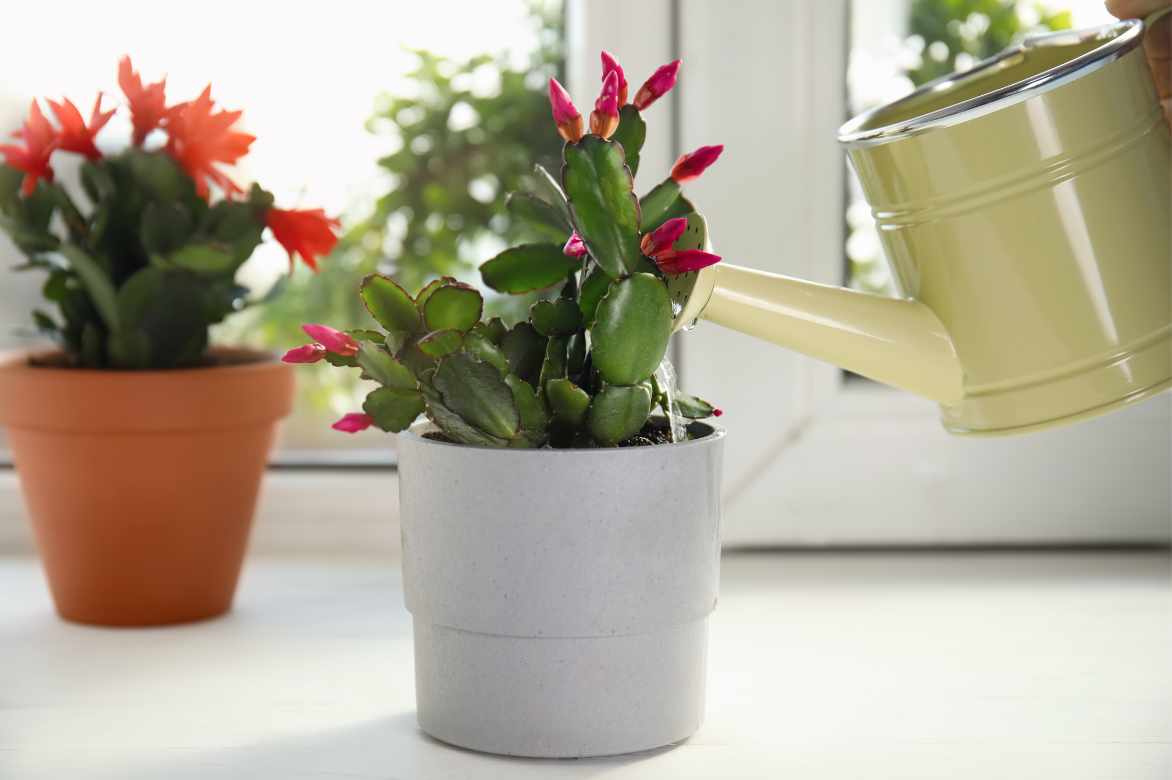
Fertilisation
Fertilisation supports growth and promotes flowering if properly dosed.
- Use a liquid fertiliser for cacti, diluted to half strength.
- Fertilise approximately every three weeks from March to September.
- Stop all fertilisation as autumn approaches to respect the rest period before flowering.
Pruning
Pruning is not essential but can be useful to control the plant’s shape or stimulate branching.
- Intervene after flowering by pinching or cutting the tips of the segments.
- This gentle operation encourages the production of new shoots, often more floriferous.
Repotting
Repotting is done every 2 to 3 years, preferably after flowering in spring.
- Choose a slightly larger pot, always with drainage holes.
- Replace the substrate entirely with a fresh, well-draining mix.
- Avoid compacting too much and do not water too much in the days following repotting.
Precautions to take
- Avoid drafts and sudden temperature changes.
- Do not move this “Christmas Cactus plant” during bud formation or flowering: this can cause them to drop.
- Occasionally clean the segments with a damp cloth to remove dust.
- Regularly check the condition of the roots if the plant shows signs of fatigue: excess moisture is often the cause.
Pests and potential diseases of the Christmas Cactus
Although the Schlumbergera is a rather resilient plant, it can occasionally be susceptible to a few parasitic pests and diseases, especially under suboptimal growing conditions.
Common Parasites
Mealybugs
These are the most frequent parasites on Schlumbergera. They appear as small white cottony clusters nestled at the base of the segments or in the crevices of the plant. They weaken the plant by sucking the sap.
→ Natural solution: Clean the affected areas with a cotton pad soaked in 70°C alcohol, or spray a solution of warm water mixed with black soap (1 tablespoon per litre). Repeat every 3 to 4 days until they disappear. Read more: Mealybugs: Identification and Natural Treatments.
Red spider mites
These tiny mites appear particularly in dry conditions. They leave small webs and discoloured pits on the segments.
→ Natural solution: Increase the ambient humidity around the plant (without misting directly), and spray an infusion of horsetail or a solution based on black soap. Neem oil as a mild treatment can also be effective. Read more: Red Spider Mites: Identification and Treatment.
Fungus gnats (sciarid flies)
These small black insects fly around the pot, and their larvae can harm the roots if the substrate remains constantly moist.
→ Natural solution: Allow the substrate to dry out longer between waterings and place yellow sticky traps. A dry sand mulch on the surface can also prevent adults from laying eggs.
Diseases
Root rot
This is a common fungal disease caused by overwatering or poorly draining substrate. The roots turn black and soft, and the segments may wilt or fall off.
→ Natural solution: Stop watering, repot the plant, prune the damaged roots, and replant in a perfectly draining substrate. Adding a bit of crushed charcoal to the mix can help disinfect the new substrate.
Spots on the segments
Sometimes caused by excessive direct sunlight or sudden temperature changes, these spots can also be fungal in origin.
→ Natural solution: Move the plant to a bright spot without intense direct sunlight, remove the affected segments, and strengthen the plant’s defences with sprays of garlic or horsetail decoction.
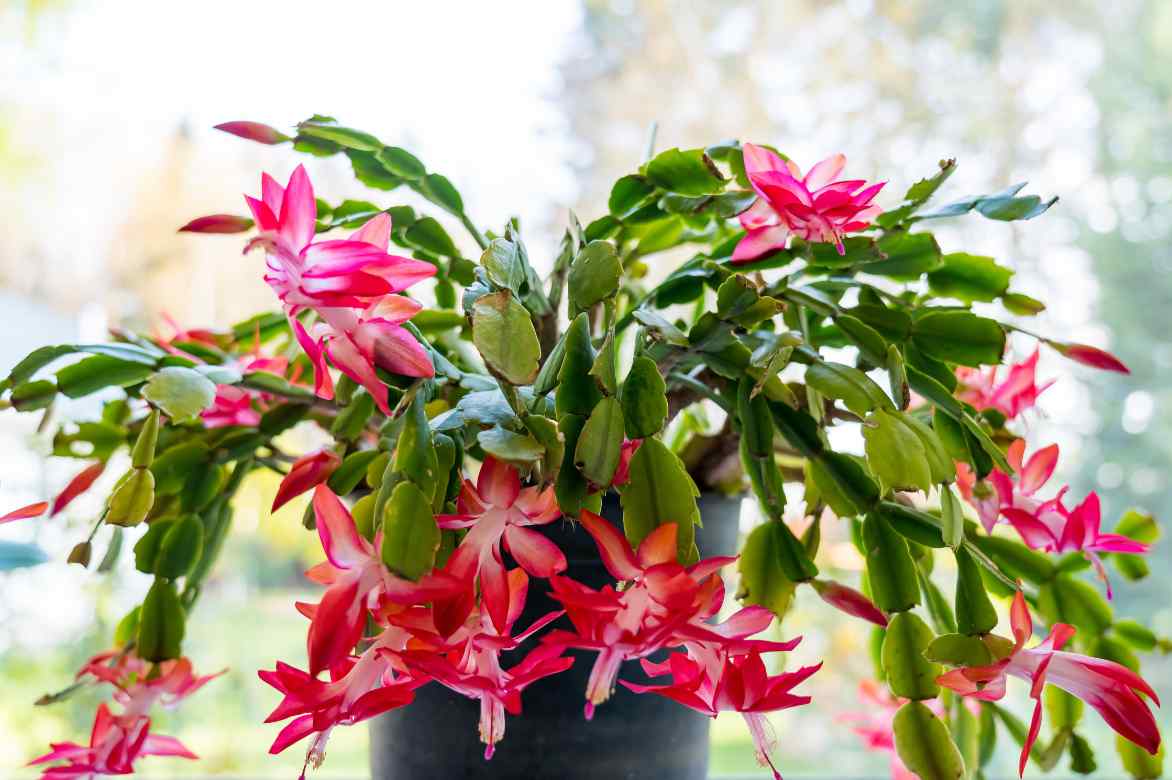
Schlumbergera truncata
How to take a cutting from a Christmas cactus?
Propagating Christmas Cactus by cuttings is very easy to do using stem segments. Here are the precise steps to follow:
- Take segments: Choose a healthy stem and take a section of 2 to 4 segments (cladodes), ideally just after flowering or in spring.
- Let them heal: Allow the segments to dry in the open air, in the shade, for 24 to 48 hours. This step helps the wound to close, reducing the risk of rot.
- Prepare the substrate: Use a light and well-draining mix composed of potting soil for houseplants or cacti, with 30% perlite or coarse sand.
- Plant the segments: Insert the base of the segments 1 to 2 cm into the substrate, keeping them slightly tilted if possible to encourage rooting.
- Press lightly: Gently press around the base to stabilise the segments without burying them completely.
- Water sparingly: Lightly moisten the substrate after a few days, then wait until it is almost completely dry before the next watering.
- Place in soft light: Position the cutting in a bright spot, but out of direct sunlight, at a temperature of around 20 °C.
- Roots usually appear within 3 to 6 weeks. You’ll know the cutting is well-rooted if it offers slight resistance when gently pulled.
- Transplant: Once the roots are well established, you can transplant the cutting into a permanent pot.
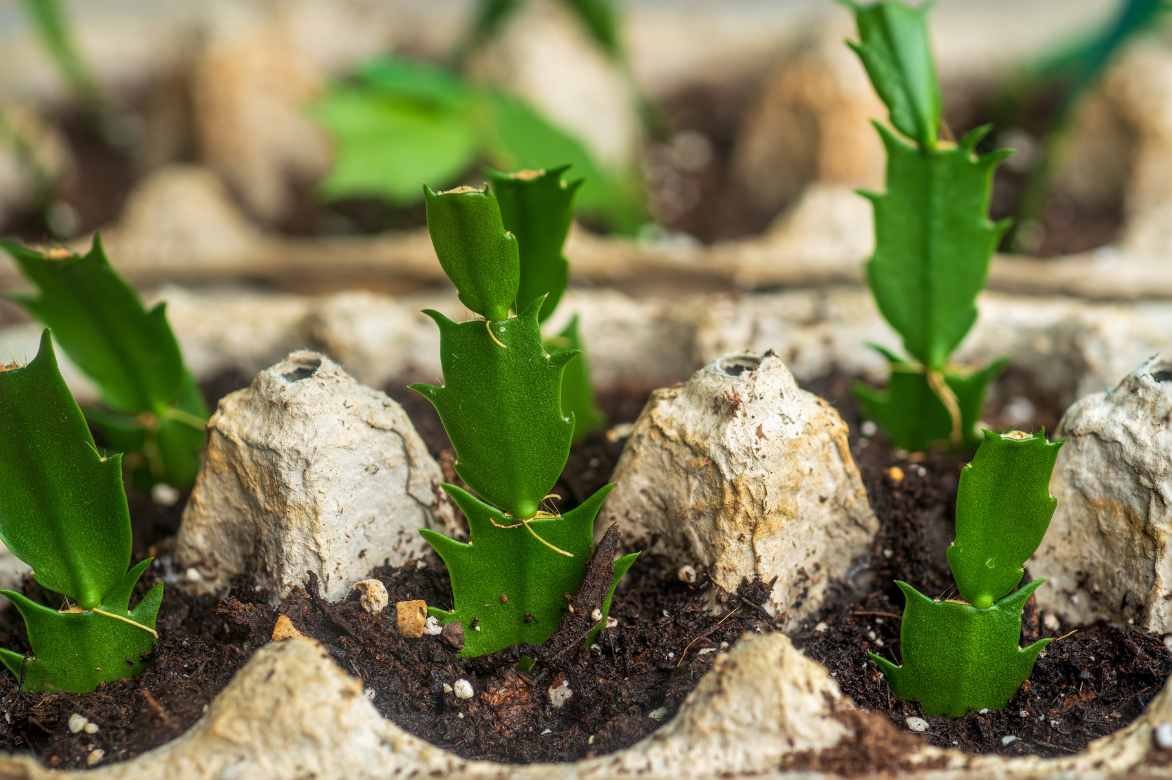
Stem propagation is the practical way to multiply a Christmas cactus, here in an egg box
How to Showcase Your Christmas Cactus in Your Home?
The flowering rhythm of the Christmas Cactus, out of season, also makes it a precious plant to brighten up our interiors in winter. While most plants enter dormancy, the Schlumbergera unfurls its trailing flowers, often in the heart of December, adding a vibrant and unexpected touch that instantly warms the atmosphere.
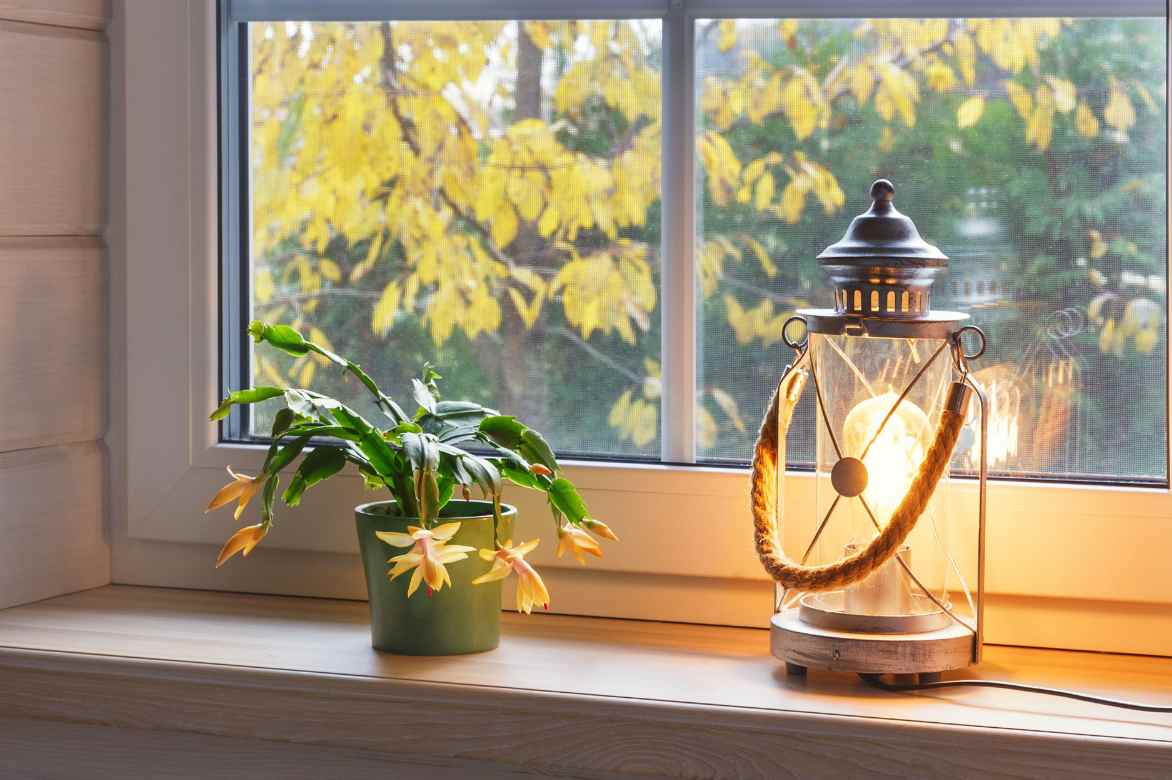
In terms of décor, it’s a chameleon-like plant that blends with astonishing ease into the most varied settings. In a Scandinavian or Japandi-style interior, it naturally finds its place thanks to its soft lines and structured foliage. Place it in a matte stoneware planter, positioned on a windowsill or shelf: its trailing stems will break up straight lines and add movement, while maintaining the harmony of a minimalist décor.
In a more bohemian or eclectic space, the Schlumbergera loves to play the natural card. Hang it in a woven bowl or place it on a raw wood piece of furniture, surrounded by artisanal pottery and textured textiles. Its colourful flowering stands out particularly well against walls with muted tones like olive green, terracotta, or clay grey.
It pairs beautifully with other plants featuring graphic silhouettes, such as a Zamioculcas zamiifolia for vertical contrast or a Sansevieria for a sculptural effect. For an interesting play on textures, you can also pair it with an Asplenium nidus: the soft, crinkled foliage of this fern highlights the flat, jointed segments of the Christmas Cactus.
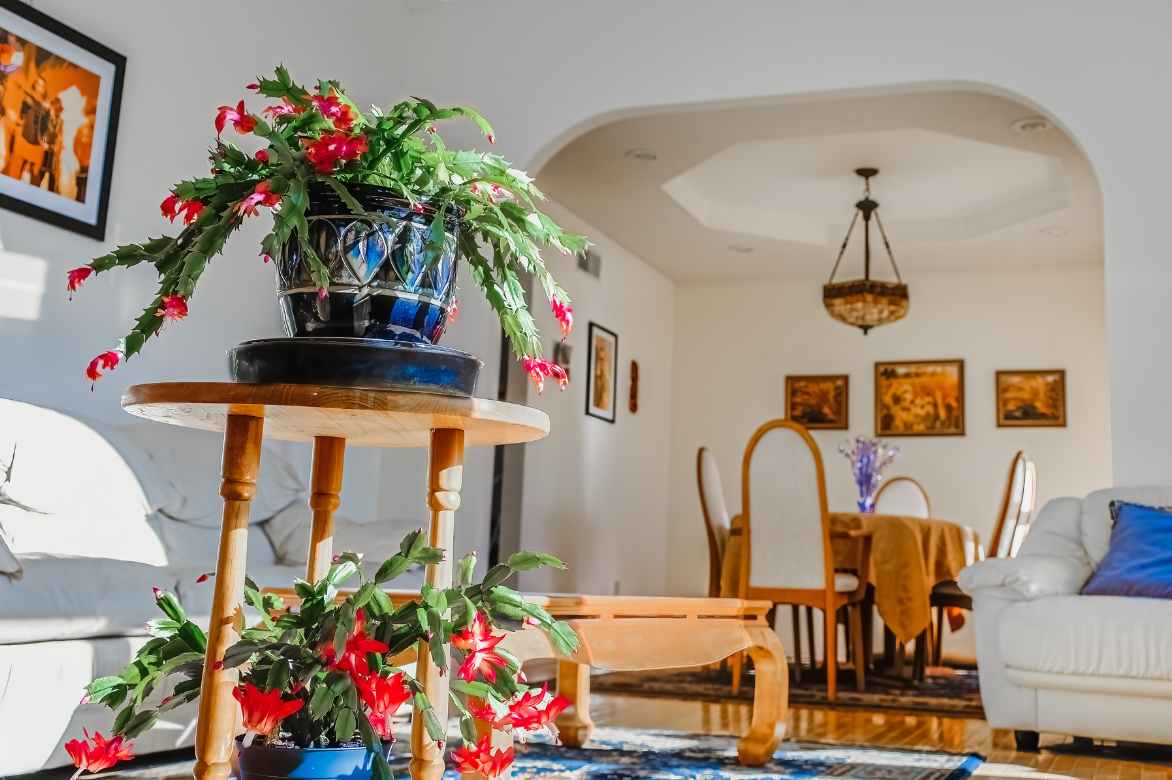
Placed high up, its trailing habit is appreciated
Also worth reading
→Discover our wide range of houseplants.
→Our decorative foliage houseplants and our flowering houseplants.
Frequently asked questions
-
When should the Christmas cactus be placed outdoors?
You can move the Christmas cactus outdoors from late spring, when nighttime temperatures stabilise above 10°C. This period usually corresponds to the second half of May. Below this threshold, the plant may experience thermal stress, which can affect its health and compromise its future flowering.
Once outside, place it in partial shade, in a spot sheltered from direct sunlight, especially during the hottest hours, as well as from heavy rain. A location under an awning, an open veranda, or in the light shade of a tree is ideal. Be sure to adjust watering: outdoors, evaporation is faster, but the soil should always dry slightly between waterings. The plant can stay outside all summer, provided it is brought back indoors as soon as temperatures drop to around 10°C in autumn.
- Subscribe!
- Contents
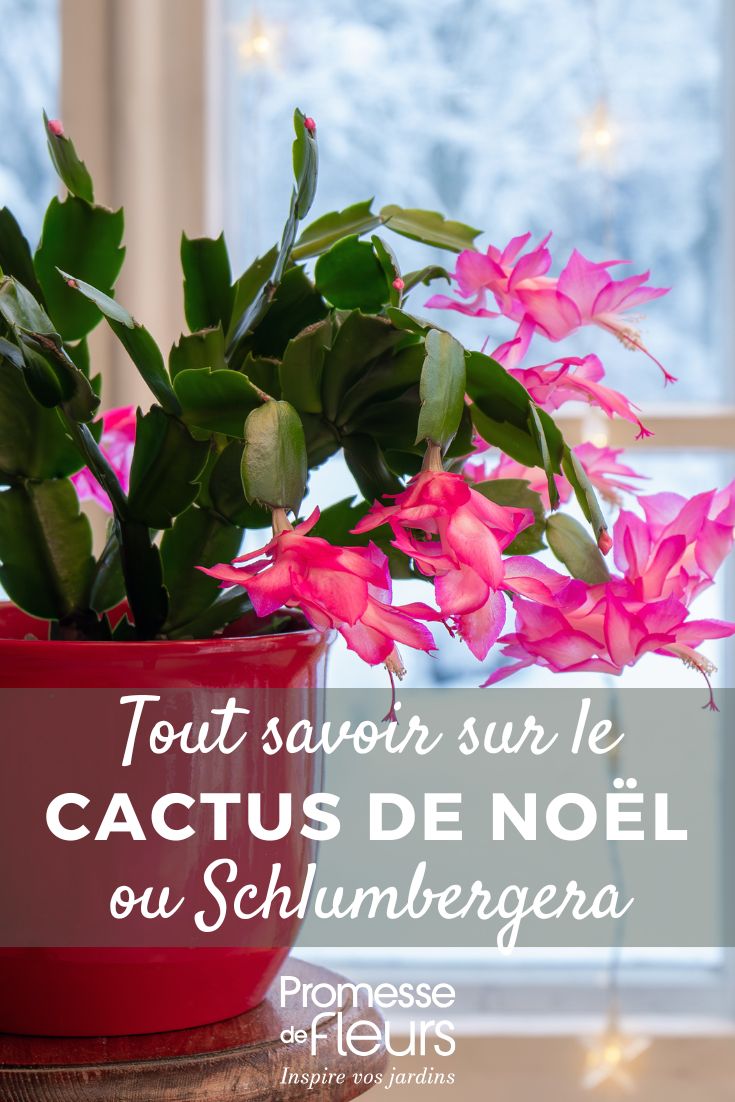































Comments